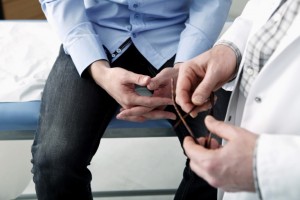January is Cervical Health Awareness Month, and as a leading cancer center serving the greater Los Angeles area, we at Pasadena CyberKnife feel this is a critically important cause. With 13,000 new cases of cervical cancer diagnosed every year, it’s important for men and women everywhere to understand the connection between cervical health and cancer, learn the best ways to protect cervical health, and take steps to prevent cervical cancer.
How to Take Care of Cervical Health
Almost every case of cervical cancer can be prevented – but only by protecting and promoting cervical health. Take these steps to protect cervical health and prevent cervical cancer in your own life and across the country:
- HPV Vaccination: For both men and women, getting an HPV vaccination is one of the most important steps to prevent cervical cancer. Keep in mind that men can get HPV and transmit the virus even if they show no symptoms.
- Quit Smoking: Smoking is another major risk factor for cervical cancer, so living tobacco-free is a great way to protect cervical health.
- Use Protection: While condoms don’t provide complete protection from HPV, they can help lower the risk of transmitting or contracting the virus.
- Get Checked: Starting at age 21, most women should receive regular Pap smears and HPV tests as a preventive measure for cervical cancer. Talk with your doctor to determine your own personal risk level for cervical cancer and decide on a screening schedule.
Contact Your Los Angeles Cancer Treatment Center
By taking these steps, you can lower your own risk for cervical cancer and help prevent the disease overall – but if you or someone you love has been diagnosed with cervical cancer, Pasadena CyberKnife may be able to help. Using the state-of-the-art, noninvasive CyberKnife System, we may be able to treat your cervical cancer without the need for surgery. Contact us today to learn more and schedule your consultation, and don’t forget to encourage everyone in your life to take steps to promote cervical health this year.
More
At Pasadena CyberKnife Center, we believe everyone deserves a happy, healthy life and to take hope even in the darkest of times. That’s why we’re proud to provide CyberKnife: a revolutionary cancer treatment method that combines some of the most advanced medical technologies in the world to create a cancer treatment that’s more comfortable, convenient, and effective than almost anything else on the market today. Thanks to its unique combination of technologies, CyberKnife comes with a variety of advantages over other treatments.
The Benefits of CyberKnife
- Versatile: Because CyberKnife can target a tumor anywhere in the body from almost any angle, it can be used to treat a wide variety of cancers including brain, lung, head & neck, prostate, and many more.
- Non-Surgical: CyberKnife treatment is performed purely through precision radiation beams, meaning there’s never any need for invasive surgery or cutting of any kind.
- Motion-Tracking: Thanks to the Synchrony Respiration Tracking System, CyberKnife can automatically measure and account for movement during normal breathing and respiration.
- Comfortable: Unlike other radiation therapies, CyberKnife doesn’t use painful braces and restraints during treatment. All the patient needs to do is lie still on a comfortable platform as CyberKnife attacks their cancerous tumor.
- Precise: CyberKnife’s advanced targeting systems mean there’s minimal damage to surrounding tissues and cells.
- Convenient: CyberKnife has almost no side effects and no recovery time, so patients can continue going about their daily lives during treatment. While other forms of treatment often require 30-40 sessions, CyberKnife typically requires only 1-5 fraction treatments.
- Effective: CyberKnife is one of the most effective cancer treatments on the market today, and we’ll continually monitor the tumor to ensure treatment was effective.
Contact Your Pasadena, CA Cancer Treatment Center
A cancer diagnosis used to be a death sentence, but with CyberKnife, there’s new hope. If you or a loved one has recently been diagnosed with cancer, don’t wait – contact us today. Feel free to call us at (626) 325-0777 with any questions, or if you’d like to schedule a consultation, you can reach out to us at our contact page. We can’t wait to hear from you, and we look forward to helping you free yourself from cancer and reclaim your life.
More
Could Home Remedies Help With Your Trigeminal Neuralgia Pain?
 Trigeminal neuralgia can cause what some sufferers have described as blinding pain in the cheek, jaw, forehead, eye, and teeth on one side of the face. Pain can affect both sides of the face, but this is very rare and pain symptoms will affect only one side of the face at a time. The shooting pains have been likened to an electrical shock and an episode of trigeminal neuralgia pain can last up to two minutes.
Trigeminal neuralgia can cause what some sufferers have described as blinding pain in the cheek, jaw, forehead, eye, and teeth on one side of the face. Pain can affect both sides of the face, but this is very rare and pain symptoms will affect only one side of the face at a time. The shooting pains have been likened to an electrical shock and an episode of trigeminal neuralgia pain can last up to two minutes.
Trigeminal neuralgia treatment often involves medications or surgery. Stereotactic body radiation therapy (SBRT) can treat trigeminal neuralgia pain in a safe and non-invasive way by damaging the nerve responsible for the pain. It can take several weeks for SBRT to effectively relieve pain and symptoms can recur — although if necessary, SBRT can easily be repeated to achieve a more complete treatment. While you’re waiting for treatment to take full effect, you can try some home remedies to try and reduce trigeminal neuralgia pain by using heat, cold, or pressure.
Apply Heat or Cold to the Painful Area
Many people find relief from trigeminal neuralgia pain by applying heat to the affected area. You can do this locally by pressing a hot water bottle or other hot compress to the painful spot. Heat a beanbag or warm a wet washcloth in the microwave for this purpose. You can also try taking a hot shower or bath. If one is available, sit in a hot sauna.
Cold may also help relieve the pain, although you’ll obviously want to avoid this remedy if you’re one of the many trigeminal neuralgia sufferers for whom cold triggers symptoms. But if you think applying cold to the affected area might help relieve your symptoms until you can get SBRT or while you’re waiting for it to take effect, you can use an ice pack wrapped in a thin towel or pillowcase to numb the painful area. Keep the cold in contact with the affected area for about 30 seconds or until the area begins to feel numb. Some trigeminal neuralgia sufferers find that switching between the hot and cold compresses helps more.
 Apply Pressure to the Painful Area
Apply Pressure to the Painful Area
While many people find that a light touch — often as light as a gentle breeze wafting over their skin — can trigger trigeminal neuralgia symptoms, they also find that applying pressure to the area can help relieve symptoms. Use your entire hand to press on the affected area. You may need to apply a reasonable amount of pressure in order to get results.
Know Your Triggers
The more you know about what triggers your trigeminal neuralgia pain, the better equipped you’ll be to avoid those triggers and completely escape painful symptoms more often. Some common triggers include eating, talking, brushing teeth, cold, and light touches to the face. Things you wouldn’t expect can trigger trigeminal neuralgia pain, too. One woman reported that peppermint candy triggered her symptoms. If you can’t figure out what’s causing your pain, it may be helpful to keep a pain diary in which you record key details of your environment and activity in order to look for common threads among different symptom flare-ups.
While home remedies may not be capable of completely curing trigeminal neuralgia symptoms, they can be very useful for people who are waiting for treatment or who still have to make it through the recovery period in which symptoms gradually recede after SBRT. No matter where you fall on the spectrum, you’ll be glad to experience relief from your trigeminal neuralgia pain.
More
Quit Smoking to Improve Your Prostate Cancer Treatment Outcomes
 According to the results of a new study, men who smoke during prostate cancer treatment are not only more likely to experience treatment side effects, they’re also more likely to experience a recurrence or even die from prostate cancer.
According to the results of a new study, men who smoke during prostate cancer treatment are not only more likely to experience treatment side effects, they’re also more likely to experience a recurrence or even die from prostate cancer.
While men who have never smoked before in their lives run the least risk of experiencing prostate cancer treatment side effects, cancer recurrence, or death, the study found that even men who quit smoking right before beginning cancer treatment enjoyed better treatment outcomes than those who continued smoking throughout treatment.
Smoking Makes Prostate Cancer Treatment Less Effective
The study, performed by researchers from New York City’s Memorial Sloan Kettering Cancer Center and published in the journal BJU International, examined the effects of smoking history among a group of 2,358 patients who received external beam radiotherapy for prostate cancer between 1988 and 2005. 2,156 of the study participants had some kind of smoking history. Researchers divided the patients into four categories: never smokers, current smokers, former smokers, and current smoking status unknown. Even those participants who quit smoking right before beginning prostate cancer treatment were included in the “former smoker” category.
The researchers followed up with the study participants eight years after they received treatment. They found that patients who smoked during the cancer treatment had a 40 percent higher risk of relapse. Those who smoked during treatment were also twice as likely to experience prostate cancer metastasis and to die from prostate cancer, when compared to those who had never smoked.
 Patients who were considered former smokers under the terms of the study also had a slightly elevated risk of cancer recurrence, metastasis, and death, but their risks were somewhat lower than those of patients who smoked throughout cancer treatment. Ten years later, only about 52 percent of patients who smoked throughout treatment had not suffered a recurrence of prostate cancer, while 63 percent of former smokers and 66 percent of never smokers were still in the clear.
Patients who were considered former smokers under the terms of the study also had a slightly elevated risk of cancer recurrence, metastasis, and death, but their risks were somewhat lower than those of patients who smoked throughout cancer treatment. Ten years later, only about 52 percent of patients who smoked throughout treatment had not suffered a recurrence of prostate cancer, while 63 percent of former smokers and 66 percent of never smokers were still in the clear.
While today’s patients can choose from a far wider range of prostate cancer treatment options, external beam radiotherapy remains one of the oldest treatments for the disease. There is no reason to believe that the impact of smoking on the efficacy of other prostate cancer treatments, like stereotactic body radiation therapy (SBRT), would be any different than its impact on the efficacy of external beam radiotherapy. The study authors believe that smoking could contribute to the formation of more aggressive cancer tumors. They also speculate that smoking during cancer treatment could interfere with treatment by lowering oxygen levels within tumor cells, making them less susceptible to the effects of radiation.
In addition to an enhanced risk of cancer recurrence, metastasis, and death, current and former smokers involved in the study also experienced a greater risk of a range of urinary side effects. These side effects included urinary incontinence, urinary toxicity, bladder hemorrhage, and urinary retention.
If you want to improve your chances of a good treatment outcome for prostate cancer, you might want to consider quitting smoking. While researchers don’t yet fully understand the relationship between smoking and prostate cancer, new evidence suggests that smoking during treatment can make treatment less effective. If you’re a smoker who’s already been diagnosed with prostate cancer, it’s not too late — quitting smoking can still make a difference, even if you do it right before you start treatment.
More
How to Deal With Physical Changes After Cancer Treatment Ends
 Even after cancer treatment ends, you may find that you are still coping with physical changes related to treatment. These changes can range from reduced strength and endurance to lasting fatigue, pain, weight changes, and sexual changes.
Even after cancer treatment ends, you may find that you are still coping with physical changes related to treatment. These changes can range from reduced strength and endurance to lasting fatigue, pain, weight changes, and sexual changes.
While you may be able to counteract many of these lasting side effects with regular exercise, good nutrition, and other positive lifestyle changes, many side effects may linger for months or years after treatment ends, and it’s important to know how to cope.
Fatigue
No matter what kind of cancer you’ve suffered or what kind of treatment you’ve received, you may experience fatigue for a long time after your treatment ends. This kind of fatigue doesn’t go away with sleep. Though researchers don’t yet understand what causes treatment-related fatigue in cancer patients, it may occur due to poor nutrition, dehydration, anemia, pain, and depression.
Gentle exercise, relaxation, pain control, good nutrition, and drinking more fluids can help combat fatigue. Ask your treatment team about ways to fight fatigue. The causes of fatigue in people who have finished cancer treatment are different from the causes of fatigue in people who are still receiving treatment, so if you experienced fatigue during treatment, don’t be surprised if the solutions change.
Pain
Lingering pain may occur due to nerve damage caused by chemotherapy or damage to the skin caused by radiation therapy. Surgery scars can also cause pain after treatment ends. Some therapies for post-treatment pain include:
- Antidepressants or narcotic painkillers
- Acupuncture
- Physical therapy
- Braces
- Yoga
- Meditation
- Hypnosis
- Nerve blocks or other surgery
You can lower your risk of post-treatment pain with SBRT, a form of radiation therapy that minimizes damage to healthy tissue to reduce or eliminate complications.
 Weight Changes
Weight Changes
Some kinds of cancer therapy can cause weight gain, and after treatment, survivors find that it’s even harder than it should be to lose the weight because normal methods of weight loss don’t work. Chemotherapy can cause patients to lose muscle tissue and gain fatty tissue. Other survivors struggle with the opposite problem — they lose weight and can’t gain it back.
If you’re trying to lose weight after cancer treatment, you may want to try a combination of strength-training exercises and a healthy, low-calorie diet. If you want to gain more weight after cancer treatment, you may want to try:
- Eating several smaller meals instead of three larger ones.
- Eating more of your favorite foods.
- Making your meals look attractive.
- Using sauces, savory vegetables, and other seasonings to add flavor to foods.
Sexual Changes
Sexual changes are common after cancer treatment, especially among people who have had breast, prostate, or other reproductive cancer treatment. Survivors report losing interest in sex because of changes in body image, fatigue, pain, or simply a lowered sex drive. Others experience physical problems that make it harder to be intimate. Whatever the problem, it’s important that you ask your doctor about medication, counseling, or other therapies that can help resolve it. A sex therapist may also be able to help you and your partner come up with solutions.
Physical changes like pain and fatigue can persist for months after cancer treatment ends — some changes may last even longer. While it’s easy to get discouraged in the face of lingering cancer treatment side effects, try not to let these physical changes get you down. With time and a little creativity, you’ll soon find ways to enjoy yourself in spite of any lasting treatment side effects — and you may even find that most side effects do go away eventually, even if it takes a while.
More




 Patients who were considered former smokers under the terms of the study also had a slightly elevated risk of cancer recurrence, metastasis, and death, but their risks were somewhat lower than those of patients who smoked throughout cancer treatment. Ten years later, only
Patients who were considered former smokers under the terms of the study also had a slightly elevated risk of cancer recurrence, metastasis, and death, but their risks were somewhat lower than those of patients who smoked throughout cancer treatment. Ten years later, only 
